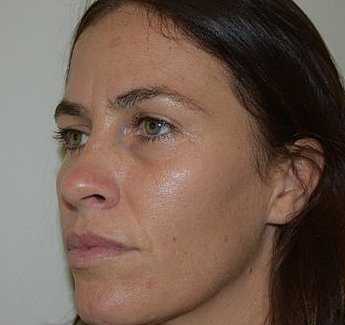What is it?
Dermal fillers (also called fillers, facial soft tissue fillers and wrinkle fillers) are composed of hyaluronic acid gel, which can be used to add or restore volume. Hyaluronic acid is a naturally occurring substance found in the skin, muscles and tendons. They are commonly used to restore volume to the face, smooth out wrinkles, plump lips and enhance cheek volume. Different dermal filler brand names include Juvaderm, Perlane, Restylane and Belotero
What can dermal fillers correct?
The type of filler your Cosmetic Doctor or Cosmetic Nurse uses will depend on the location you are you having it. At your consultation they will also take into account how much filler is needed, how long it lasts and your skin type.
Dermal fillers are commonly used in the following areas:
- Cheek bones (fillers can plump up and increase cheek firmness)
- Deep scars
- Deep nasolabial folds (your smile lines from the mouth to the nose)
- Facial lines and wrinkles
- Jawline (to create more definition)
- Lips (to add volume and definition)
- Loss of facial volume
- Marionette lines (from your mouth to the chin)
- Sagging contours
- Tear troughs (the under eye area that is prone to bags, lines and shadows)
Who is it for?
People who get dermal fillers want to add volume to their face while reducing lines and wrinkles. During the natural ageing process, facial skin will start to droop down. It’s at this point that people decide to get dermal fillers so they can restore the glow, youthfulness and freshness of their face.
How are dermal fillers performed?
After cleaning the injection sites, the medical professional will chill your skin using ice. They may also use anaesthetic ointment and/or inject local anaesthesia. Once the injection site is numbed, the hyaluronic acid filler is injected into the target area to restore volume or enhance the feature. They will then massage the area and evaluate the results to assess whether more filler is required. The filler injection process is typically quick and can often be completed in about 15 minutes. If there are several areas to be treated it can take up to an hour.
While recovery from dermal filler injections is a simple process, it is important to note you will most likely experience bruising and swelling. Icing the injection sites and avoiding strenuous activity for 24-48 hours is beneficial to the recovery process. Minor reactions after the filler treatment can include:
- Bruising
- Slight redness and/or slight itching
- Swelling
- Minimal pain and tenderness
These reactions usually disappear a few days after the treatment. It is important to note however that reactions will vary from person to person.
Are dermal fillers safe?
The ingredients used to produce dermal fillers replicate the body’s own hyaluronic acid. This significantly reduces the risk of complications and allergic reaction. However it is important to discuss any concerns you may have with your Cosmetic Doctor or Cosmetic Nurse.
How long do dermal fillers last for?
While one of the advantages of dermal fillers is that they are long lasting, they are not permanent. The duration depends on your:
- Age
- Lifestyle
- Skin type
- Skin condition
Depending on the area and type of filler used it is normally recommended you have further treatment every 6 to 24 months.
Key facts about dermal fillers
- The type and quantity of filler you have will depend on the area that is being treated.
- After your filler treatment, the effect will take 3 to 5 days to become fully apparent
- Potential complications include swelling, bleeding, brushing and lumps and bumps in the area injected
- If the dermal filler results are not what you like, the dermal filler can be dissolved with an injection of Hyalase (hyaluronidase)
- Filler treatment is relatively safe with minimal complications if a qualified Cosmetic Doctor or Cosmetic Nurse performs the procedure
- Dermal filler injections will not completely change the way you look. They simply reduce fine lines and wrinkles while adding volume to the face.
Are there any risks or complications with dermal fillers?
When performed by an experienced Cosmetic Doctor or Cosmetic Nurse, dermal fillers are a safe way to reduce fine lines and wrinkles and improve facial contours. The treatment area can stay red or swollen for a short time after the injections, however you will not need any downtime to recover.
There is a slight risk of hypersensitivity reaction or an allergic reaction with filler being used. To prevent any possible allergy complications it is highly recommended that a skin sensitivity test be undertaken.
Numbness, swelling, and redness of the treated area commonly occur after the dermal filler treatment. This is not a complication; it is just the body’s normal reaction and they will disappear in a few hours or a few days. Other complications include the formation of bumps, nodules, granulomas, cysts, or irregularities at the injection site. While there is a risk of infection occurring, this is extremely rare.
To reduce any risks and complications it is very important to choose a qualified and highly trained Cosmetic Doctor or Cosmetic Nurse
How to find the best dermal filler providers in Australia
Finding an experienced medical professional to administer your dermal filler treatment will help ensure the best results. While the procedure does not seem complex, it requires skill, precision and knowledge. Find the best Cosmetic Doctors and Cosmetic Nurses to perform dermal filler injections here
Important to know
So you can make an informed decision, your physician will discuss the possible risks associated with dermal fillers. Although the majority of patients do not experience these complications, it’s important to understand how they can be managed in the event that they occur.





